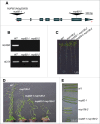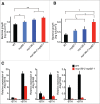Nup82 functions redundantly with Nup136 in a salicylic acid-dependent defense response of Arabidopsis thaliana
- PMID: 28071978
- PMCID: PMC5499915
- DOI: 10.1080/19491034.2017.1279774
Nup82 functions redundantly with Nup136 in a salicylic acid-dependent defense response of Arabidopsis thaliana
Abstract
The nuclear pore complex (NPC) comprises more than 30 nucleoporins (Nups). NPC mediates macromolecular trafficking between the nucleoplasm and the cytoplasm, but specific roles of individual Nups are poorly understood in higher plants. Here, we show that the novel nucleoporin unique to angiosperm plants (designated as Nup82) functions in a salicylic acid-dependent defense in a redundant manner with Nup136, which is a component of the nuclear basket in the NPC. Arabidopsis thaliana Nup82 had a similar amino acid sequence to the N-terminal half of Nup136 and a Nup82-GFP fusion was localized on the nuclear envelope. Immunoprecipitation and bimolecular fluorescence complementation analyses revealed that Nup82 interacts with the NPC components Nup136 and RAE1. The double knockout mutant nup82 nup136 showed severe growth defects, while the single knockout mutant nup82 did not, suggesting that Nup82 functions redundantly with Nup136. nup82 nup136 impaired benzothiadiazole (an analog of salicylic acid)-induced resistance to the virulent bacteria Pseudomonas syringae pv. tomato DC3000. Furthermore, transcriptome analysis of nup82 nup136 indicates that deficiency of Nup82 and Nup136 causes noticeable downregulation of immune-related genes. These results suggest that Nup82 and Nup136 are redundantly involved in transcriptional regulation of salicylic acid-responsive genes through nuclear transport of signaling molecules.
Keywords: Arabidopsis thaliana; Nup136/Nup1; Nup82; nuclear envelope; nucleoporin; plant immunity; proteome; transcriptome.
Figures




Similar articles
-
Evolutionarily conserved protein motifs drive interactions between the plant nucleoskeleton and nuclear pores.Plant Cell. 2023 Nov 30;35(12):4284-4303. doi: 10.1093/plcell/koad236. Plant Cell. 2023. PMID: 37738557 Free PMC article.
-
Involvement of the nuclear pore complex in morphology of the plant nucleus.Nucleus. 2011 May-Jun;2(3):168-72. doi: 10.4161/nucl.2.3.16175. Nucleus. 2011. PMID: 21818409 Free PMC article.
-
The Arabidopsis thaliana JASMONATE INSENSITIVE 1 gene is required for suppression of salicylic acid-dependent defenses during infection by Pseudomonas syringae.Mol Plant Microbe Interact. 2006 Jul;19(7):789-800. doi: 10.1094/MPMI-19-0789. Mol Plant Microbe Interact. 2006. PMID: 16838791
-
Functional insights of nucleocytoplasmic transport in plants.Front Plant Sci. 2014 Apr 2;5:118. doi: 10.3389/fpls.2014.00118. eCollection 2014. Front Plant Sci. 2014. PMID: 24765097 Free PMC article. Review.
-
Roles of Nuclear Pores and Nucleo-cytoplasmic Trafficking in Plant Stress Responses.Front Plant Sci. 2017 Apr 12;8:574. doi: 10.3389/fpls.2017.00574. eCollection 2017. Front Plant Sci. 2017. PMID: 28446921 Free PMC article. Review.
Cited by
-
Function of Nuclear Pore Complexes in Regulation of Plant Defense Signaling.Int J Mol Sci. 2022 Mar 11;23(6):3031. doi: 10.3390/ijms23063031. Int J Mol Sci. 2022. PMID: 35328452 Free PMC article. Review.
-
Nucleocytoplasmic Communication in Healthy and Diseased Plant Tissues.Front Plant Sci. 2021 Jul 28;12:719453. doi: 10.3389/fpls.2021.719453. eCollection 2021. Front Plant Sci. 2021. PMID: 34394173 Free PMC article. Review.
-
NUA positively regulates plant immunity by coordination with ESD4 to deSUMOylate TPR1 in Arabidopsis.New Phytol. 2024 Jan;241(1):363-377. doi: 10.1111/nph.19287. Epub 2023 Oct 2. New Phytol. 2024. PMID: 37786257 Free PMC article.
-
Regulation of Plant Immunity by Nuclear Membrane-Associated Mechanisms.Front Immunol. 2021 Dec 6;12:771065. doi: 10.3389/fimmu.2021.771065. eCollection 2021. Front Immunol. 2021. PMID: 34938291 Free PMC article. Review.
-
Evolutionarily conserved protein motifs drive interactions between the plant nucleoskeleton and nuclear pores.Plant Cell. 2023 Nov 30;35(12):4284-4303. doi: 10.1093/plcell/koad236. Plant Cell. 2023. PMID: 37738557 Free PMC article.
References
-
- Speese SD, Ashley J, Jokhi V, Nunnari J, Barria R, Li Y, Ataman B, Koon A, Chang YT, Li Q, et al.. Nuclear envelope budding enables large ribonucleoprotein particle export during synaptic Wnt signaling. Cell 2012; 149:832-46; PMID:22579286; https://doi.org/10.1016/j.cell.2012.03.032 - DOI - PMC - PubMed
-
- Roberts K, Northcote DH. Structure of the nuclear pore in higher plants. Nature 1970; 228:385-6; PMID:5473989; https://doi.org/10.1038/228385a0 - DOI - PubMed
-
- Fiserova J, Goldberg MW. Relationships at the nuclear envelope: lamins and nuclear pore complexes in animals and plants. Biochem Soc Trans 2010; 38:829-31; PMID:20491671; https://doi.org/10.1042/BST0380829 - DOI - PubMed
-
- Fiserova J, Kiseleva E, Goldberg MW. Nuclear envelope and nuclear pore complex structure and organization in tobacco BY-2 cells. Plant J 2009; 59:243-55; PMID:19392704; https://doi.org/10.1111/j.1365-313X.2009.03865.x - DOI - PubMed
-
- Rout MP, Aitchison JD, Suprapto A, Hjertaas K, Zhao Y, Chait BT. The yeast nuclear pore complex: composition, architecture, and transport mechanism. J Cell Biol 2000; 148:635-51; PMID:10684247; https://doi.org/10.1083/jcb.148.4.635 - DOI - PMC - PubMed
Publication types
MeSH terms
Substances
LinkOut - more resources
Full Text Sources
Other Literature Sources
Molecular Biology Databases
